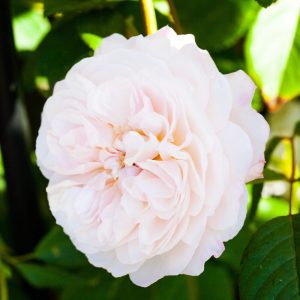Description
Rosa ‘Duchess of Cornwall’ is a stunning shrub rose with a delightful light fragrance. This repeat-flowering rose produces large, cupped blooms of soft pink with a subtle apricot hue that fade to a pale pink over time. The flowers are held on sturdy stems and have a high petal count, giving them a luxuriant appearance. The dark green foliage provides a beautiful backdrop to the blooms. This rose is perfect for planting in borders, where it will make a striking display. It can also be grown in pots or containers on a patio. Companion plants for Rosa ‘Duchess of Cornwall’ include lavender, salvia, and alliums.
Key Facts
- Common Name(s):Duchess of Cornwall Rose
- Hardiness:Fully hardy
- How big will I get? Rosa ‘Duchess of Cornwall’ can grow to a height of 1m and a spread of 1m.
- Did You Know That:The oldest living rose is thought to be 1,000 years old and can be found in Hildesheim, Germany?
Plant Calendar
A rough guide to how this plant will change through the year.
| Jan | Feb | Mar | Apr | May | June | July | Aug | Sept | Oct | Nov | Dec | |
| Flowering Time |   |
  |
  |
  |
||||||||
| Foliage Colour |  |
 |
 |
 |
 |
 |
 |
 |
 |
| J | F | M | A | M | J | J | A | S | O | N | D |
  |
  |
  |
  |
||||||||
 |
 |
 |
 |
 |
 |
 |
 |
 |
Care Guide

Soil Requirements
Rosa ‘Duchess of Cornwall’ prefers moist but well-draining soil. This plant can grow in soil with a wide range of pH levels, it is not picky about the pH level of the soil.

Best Position
Rosa ‘Duchess of Cornwall’ prefers a sheltered position and requires full sun to thrive, this consists of more than six hours of direct sunshine per day.

Maintenance
Rosa ‘Duchess of Cornwall’ should be pruned in late winter or early spring, before new growth begins. Begin by removing any dead, damaged, or diseased wood from the plant, making sure to sterilize your pruning shears between cuts to prevent the spread of disease. Next, cut back any old wood to encourage the growth of new shoots, cutting back to a healthy bud or lateral branch. Remove any weak or spindly growth that won’t produce good blooms, focusing on leaving strong, healthy shoots that will produce plenty of flowers. Finally, shape the plant by cutting back any overly long or unruly shoots, creating a more compact, attractive plant. By following these steps, you can keep your shrub roses healthy and blooming beautifully year after year.

Pest, Diseases and Wildlife
Rosa ‘Duchess of Cornwall’ can have problems with aphids, leafhoppers, and scale insects , it can be vulnerable to certain diseases such as black spot, rust and powdery mildews. It is also known to attract bees, butterflies and other pollinators. It is not considered to be toxic.





